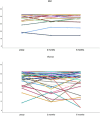Kidney Donors' Perceived and Measured Stress Levels Before and After Donation, a Longitudinal Cohort Study
- PMID: 40474760
- PMCID: PMC12142284
- DOI: 10.1111/ctr.70208
Kidney Donors' Perceived and Measured Stress Levels Before and After Donation, a Longitudinal Cohort Study
Abstract
Introduction: Transplantation with a kidney from a living donor has superior long-term patient and graft survival compared to a kidney from a deceased donor. For a kidney donor, feelings of stress may exist at different stages of the donation process. The aim of the study was to evaluate living kidney donors' perceived and measured stress levels before and after donation.
Methods: In this prospective observational cohort study with longitudinal follow-up, kidney donors were invited to answer three self-rating questionnaires targeting stress, vital exhaustion, and depressive symptoms the day before and two and six months after kidney donation. At the same time points, blood and saliva samples of insulin, glucose, and cortisol were collected.
Results: Analyses were based on data from seventy-five individuals, with a mean age 46.5 (11) years, 60% women. The kidney donors scored low in self-rating stress, exhaustion and depression both pre- and two and six months post-donation, and no correlations were established between self-reported measures and metabolic stress biomarkers. Post-donation, however, a gender difference emerged, with women reporting decreased vitality scores 32.1 (9.3) and 30.7 (11.6) at two and six months versus men reporting increased scores 35.8 (6.9) and 36.9 (7.1). Six months post-donation, women also reported more symptoms of depression than men, 12.2 (12.5) versus 6.4 (8.2) (p = 0.058).
Conclusions: Kidney donors' self-reported and measured stress levels and depressive symptoms were low and did not change from pre-donation up to six months after donation. The low levels of subjective and objective stress reported by the donors support the limited risks associated with living kidney donation. However, six months post-donation, women reported more feelings of exhaustion and depression than did men.
Practitioner points: (1) The low levels of subjective and objective stress reported by kidney donors support the limited risks associated with living kidney donation. (2) Because most kidney donors are women, the gender difference in perceived stress levels presented in this study is of clinical relevance. (3) A more structured psychosocial follow-up could enable the identification of individuals in need of more psychological follow-up post-donation.
Keywords: gender difference; living kidney donors; self‐reported questionnaires; stress level.
© 2025 The Author(s). Clinical Transplantation published by Wiley Periodicals LLC.
Conflict of interest statement
The authors declare no conflicts of interest.
Figures

Similar articles
-
Specialist breast care nurses for support of women with breast cancer.Cochrane Database Syst Rev. 2021 Feb 3;2(2):CD005634. doi: 10.1002/14651858.CD005634.pub3. Cochrane Database Syst Rev. 2021. PMID: 34559420 Free PMC article.
-
Beyond the gift: exploring mental health and quality of life after kidney donation in a resource limited country.J Nephrol. 2025 May;38(4):1209-1217. doi: 10.1007/s40620-025-02217-5. Epub 2025 Apr 30. J Nephrol. 2025. PMID: 40307661
-
Psychological therapies for treatment-resistant depression in adults.Cochrane Database Syst Rev. 2018 May 14;5(5):CD010558. doi: 10.1002/14651858.CD010558.pub2. Cochrane Database Syst Rev. 2018. PMID: 29761488 Free PMC article.
-
Psychological therapies for the treatment of mental disorders in low- and middle-income countries affected by humanitarian crises.Cochrane Database Syst Rev. 2018 Jul 5;7(7):CD011849. doi: 10.1002/14651858.CD011849.pub2. Cochrane Database Syst Rev. 2018. PMID: 29975811 Free PMC article.
-
Online support groups for women with breast cancer.Cochrane Database Syst Rev. 2017 Mar 10;3(3):CD011652. doi: 10.1002/14651858.CD011652.pub2. Cochrane Database Syst Rev. 2017. PMID: 28278559 Free PMC article.
References
-
- Svensk Transplantationsförening . Svensk Transplantationsförening. 2019. Accessed January 24, 2023. https://svensktransplantationsforening.se/statistik/.
Publication types
MeSH terms
Grants and funding
LinkOut - more resources
Full Text Sources
Medical

